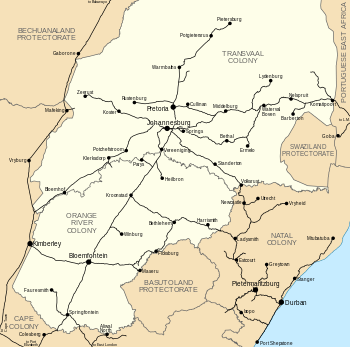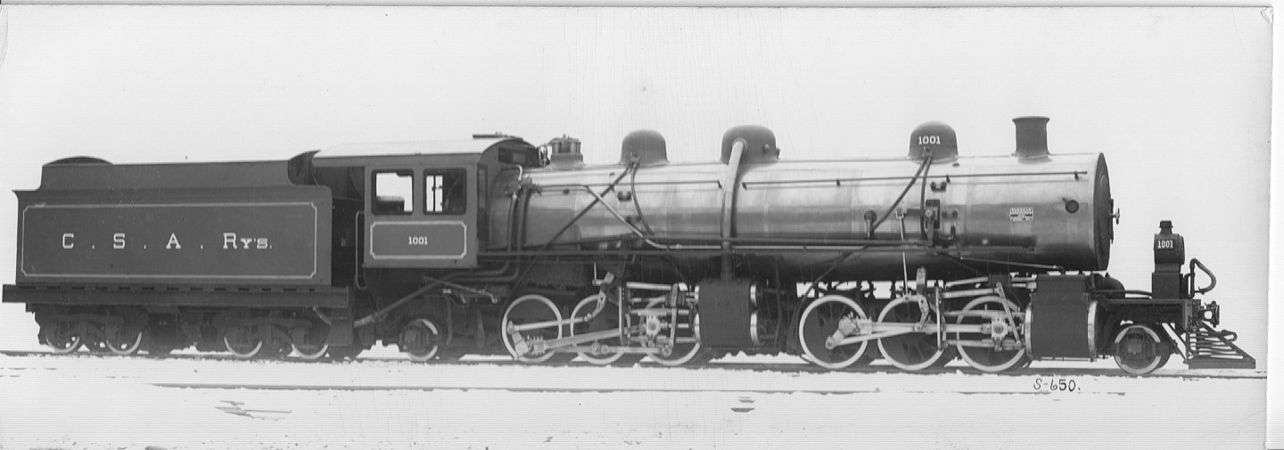South African Class MD 2-6-6-2
|
CSAR no. 1001, SAR no. 1617, c. 1910 | |||||||||||||||||||||||||||||||||||||||||||||||||||||||||||||||||||||||||||||||||||||||||||||||||||||||||||||||||
| |||||||||||||||||||||||||||||||||||||||||||||||||||||||||||||||||||||||||||||||||||||||||||||||||||||||||||||||||
| |||||||||||||||||||||||||||||||||||||||||||||||||||||||||||||||||||||||||||||||||||||||||||||||||||||||||||||||||
| |||||||||||||||||||||||||||||||||||||||||||||||||||||||||||||||||||||||||||||||||||||||||||||||||||||||||||||||||
| |||||||||||||||||||||||||||||||||||||||||||||||||||||||||||||||||||||||||||||||||||||||||||||||||||||||||||||||||
The South African Railways Class MD 2-6-6-2 of 1910 is a steam locomotive from the pre-Union era in the Transvaal.
In March 1910, the Central South African Railways commissioned a single experimental Mallet articulated compound steam locomotive with a 2-6-6-2 wheel arrangement. In 1912, when the locomotive was assimilated into the South African Railways, it was renumbered and designated Class MD.[1][2][3][4]
Manufacturer
The first Mallet articulated compound steam locomotive on the Central South African Railways (CSAR) was ordered for test purposes from the American Locomotive Company in 1910. It was numbered 1001 and placed in service in March 1910. With its full working order weight of 157 long tons (160 tonnes), it was the heaviest locomotive in the world working on Cape gauge at the time.[1][2][3][4][5]
Compound expansion
In a compound locomotive, steam is expanded in phases. After being expanded in a high-pressure cylinder and having then lost pressure and given up part of its heat, it is exhausted into a larger-volume low-pressure cylinder for secondary expansion, after which it is exhausted through the smokebox. By comparison, in the more usual arrangement of simple expansion (simplex), steam is expanded just once in any one cylinder before being exhausted through the smokebox.[1][6]
In the compound Mallet locomotive, the rear set of coupled wheels are driven by the smaller high-pressure cylinders, which are fed steam from the steam dome. Their spent steam is then fed to the larger low-pressure cylinders, which drive the front set of coupled wheels.[1][3]
Characteristics
The bar frames of the rear engine unit and its high-pressure cylinders were rigidly attached to the boiler, with the wide firebox extending over the coupled wheels. The front engine unit and its low-pressure cylinders were not rigidly attached to the boiler barrel, but carried the boiler on a single sliding bearing, which was placed between the leading and intermediate coupled wheels. The underside of the smokebox was flattened to provide clearance between it and the front engine unit. The two engine units were coupled together by a single vertical pin connection, arranged at a point on the centre-line of the high-pressure cylinder saddle casting. This arrangement gave the locomotive a short rigid wheelbase of 8 feet 4 inches (2,540 millimetres), which made it capable of traversing curves of short radius.[2]
The locomotive used saturated steam. The high-pressure cylinders had piston valves, arranged above the cylinders, while the low-pressure cylinders had Allen Richardson balanced slide valves, also arranged above the cylinders and all actuated by Walschaerts valve gear. Copper steam pipes were arranged on each side of the dome and passed vertically down outside the boiler to the steam chests of the high-pressure cylinders. The exhaust from the high-pressure cylinders passed through a receiver pipe along the centre of the engine to the low-pressure cylinders. The exhaust from the low-pressure cylinders passed through a pipe, fitted with flexible connections, to the smokebox and blast pipe.[2]
The firebox had a short combustion chamber. The boiler barrel was telescopic and made up in three courses from 5⁄8 inch (16 millimetres), 11⁄16 inch (17 millimetres) and 3⁄4 inch (19 millimetres) thick plate respectively. The Walschaerts valve motion was operated by hand screw gear, with the reversing gear arranged for one engine unit's set of gear to be raised while the other's was lowered for forward or reverse, thereby balancing each other.[2]
Performance
At low speed, the locomotive proved to be capable of handling heavier trains than any of the existing CSAR fleet of goods locomotives, but at higher speeds of 25 to 30 miles per hour (40 to 48 kilometres per hour), it could not compete successfully because of excessive wear on the moving parts, which resulted in failures and, as a consequence, high maintenance cost. Part of the problem arose from the fact that the Mallet was expected to run to the same train schedules as the non-articulated locomotive fleet, while its smaller coupled wheels made it more suited to heavy low-speed work. It has been surmised that, had it been superheated and equipped with larger diameter coupled wheels, the results may have been much better.[1][2]
Service
The Mallet was acquired as an experiment, the ultimate object being to improve traffic flow on the 80 miles (129 kilometres) coal line between Witbank and Germiston. The increase of traffic and the resultant congestion on this line, with a ruling gradient of 1 in 100 (1%), was causing considerable delays en route, which led to excessive hours of duty being imposed on crews. The intent was to determine the feasibility of replacing the existing Class 11 locomotives on this line with more powerful Mallets, to be able to increase train loads from 900 to 1,600 long tons (914 to 1,626 tonnes).[1]
South African Railways

When the Union of South Africa was established on 31 May 1910, the three Colonial government railways (Cape Government Railways, Natal Government Railways and CSAR) were united under a single administration to control and administer the railways, ports and harbours of the Union. Although the South African Railways and Harbours came into existence in 1910, the actual classification and renumbering of all the rolling stock of the three constituent railways required careful planning and was only implemented with effect from 1 January 1912.[7]
While the South African Railways (SAR) came into existence in 1910, the actual classification and renumbering of all the rolling stock of the three constituent railways required careful planning and was only implemented with effect from 1 January 1912.[4]
In 1912, the engine was renumbered 1617 and designated the sole Class MD locomotive on the SAR. It remained in service on the line between Witbank and Germiston, until it was withdrawn from service and scrapped in 1926.[1][3][4][8]
Illustration
 CSAR no. 1001, c. 1910
CSAR no. 1001, c. 1910
References
- 1 2 3 4 5 6 7 Holland, D.F. (1971). Steam Locomotives of the South African Railways, Volume 1: 1859-1910 (1st ed.). Newton Abbott, Devon: David & Charles. pp. 138–140. ISBN 978-0-7153-5382-0.
- 1 2 3 4 5 6 Espitalier, T.J.; Day, W.A.J. (1945). The Locomotive in South Africa - A Brief History of Railway Development. Chapter VI - Imperial Military Railways and C.S.A.R. (Continued). South African Railways and Harbours Magazine, March 1945. pp. 181-183.
- 1 2 3 4 Paxton, Leith; Bourne, David (1985). Locomotives of the South African Railways (1st ed.). Cape Town: Struik. p. 86. ISBN 0869772112.
- 1 2 3 4 Classification of S.A.R. Engines with Renumbering Lists, issued by the Chief Mechanical Engineer’s Office, Pretoria, January 1912, pp. 9, 12, 15, 46 (Reprinted in April 1987 by SATS Museum, R.3125-6/9/11-1000)
- ↑ "Powerful Freight and Passenger Locomotives for a Narrow Gauge Railway". American Engineer and Railroad Journal: 192–194. May 1910. Retrieved 31 December 2012.
- ↑ Compounding Steam Engines
- ↑ The South African Railways - Historical Survey. Editor George Hart, Publisher Bill Hart, Sponsored by Dorbyl Ltd., Published c. 1978, p. 25.
- ↑ Holland, D.F. (1972). Steam Locomotives of the South African Railways, Volume 2: 1910-1955 (1st ed.). Newton Abbott, Devon: David & Charles. p. 140. ISBN 978-0-7153-5427-8.
| Wikimedia Commons has media related to South African Class MD (2-6-6-2). |
_CSAR_1001.jpg)